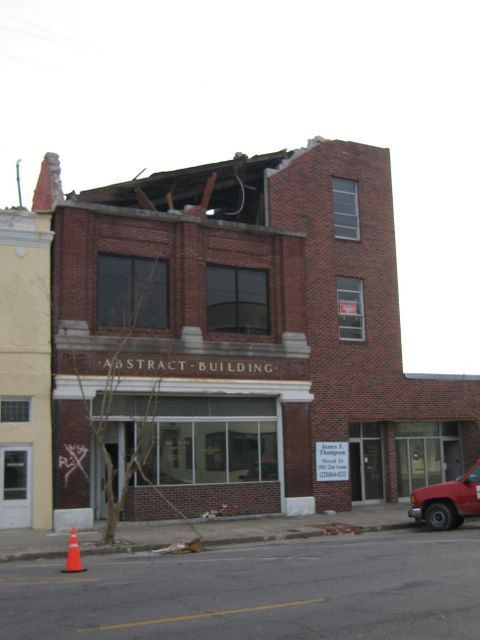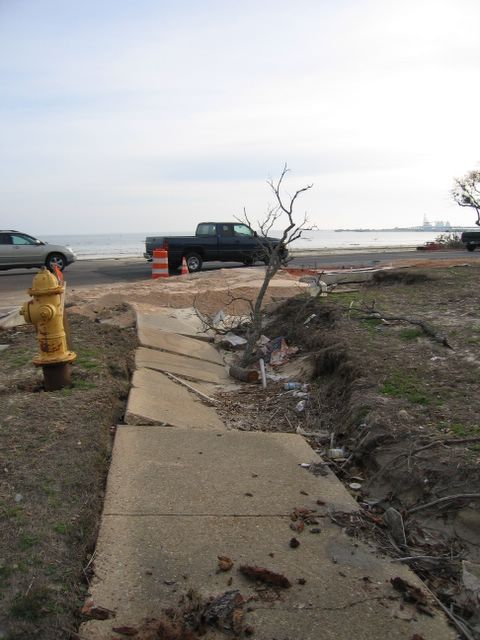Gulfport, MS - post-Katrina


The Abstract Building and Steeple from First Baptist Church


Unscathed Federal Courthouse and Destruction along Hwy 90


Street destruction along Hwy 90 and Reconstruction in progress


Gulfport Library and heritage trees all dead from saltwater


Typical house along Hwy 90 and the First Baptist Church


Dead trees and typical home
21 January 2006 Mississippi Gulf Coast status: Before getting to the Gulf, we (crew from Tufts Volunteer Vacations) were informed that there was total devastation along the coast. We were essentially prepared for war-time deployment with gallons of water per person, sufficient rations for a week (x100 people is a lot of food), tents, sleeping bags, water treatment equipment, lights, and biohazard masks + gloves. Well, turns out there is destruction along the coast, but the physical scope is much more limited than we were expecting. Don't get me wrong -- Mississippi's Gulf Coast is gone -- but that disappearance only extends three blocks inland (x whatever MS' coastline is: ~30 miles?). Yes there are indeed towns that have been completely wiped off the map -- Pass Christian, Waveland (God strikes the ironically named towns first), and Bay Saint Louis. I have yet to see these towns, but word is that there are only tent cabins serving as downtowns, providing housing, and serving as government offices. Other towns along the Gulf have damage, but are in much better shape than those three -- think of the detestation in the other towns on the scale of a multi-block fire (probably similar to Berkeley Hills fire)-- yes it's very bad for some people, but the cities are all intact, there are no shortages, nor any life-safety issues at this point.
We were based in Gulfport, which was the least impacted of the Gulf towns. Inland from the Gulf to about four blocks inland, there was significant destruction (buildings gone with just foundations visible or gutted buildings due to mildew, mold, flooding).
Destroyed area goes from Hwy 80, north four blocks. Majority of businesses are along the strip, Hwy 49/25th Ave, which extends 5 miles from Hwy 80 north to I10, so you can get a sense from that. Businesses along 49 are all open (excepting Barnes & Noble which closed and one of 3 Taco Bells), so business impact to the city of Gulfport seems minimal. Walmart + all other stores are open + providing services. No need to truck in water, food, or other items.
What we did during the week:
For the week, bulk of our efforts were focused on: debris removal from private homes, assisting with interior home renovations, debris removal from yards/properties, assisting homeowners sort through debris in their homes, and given the size of our team -- supporting our own team of 100 volunteers. Tufts teams worked in the following cities: Gulfport, Biloxi, Gautier, Pascagoula, and D'Iberville. Very fulfilling week even though we weren't fully occupied throughout the week (due to various logistical challenges), and almost all of us wanted additional projects + more assignments.
Future volunteer work:
There is no universal coordinator of volunteers. On the ground, it's local churches and other charitable organizations who are coordinating volunteer teams. Teams of volunteers as well as individual volunteers, while welcome, need to coordinate on their own with a group in MS. Current work for unskilled manual labor is not clear. There is a tremendous need for roofers, drywallers, and debris removal, but at this point, this is generally skilled/paid work and/or requires heavy equipment (debris removal).
Observations: Those who were better off before the storm are are generally doing sufficiently well after the storm. Insurance, friends, and knowing how to move forward are allowing those with resources to quickly rebuild and move on. The biggest challenge facing most of these folks is dealing with insurers who are challenging payments. Those who were less well off before the storm often have confounding issues -- lack of family support, no work, and all the problems often associated with being poor in Mississippi. They were just scraping by before the storm and are borderline after the storm.
It's like a tradeshow, but people are actually working:
Every single room at every single hotel in Mississippi from the coast, inland to Jackson from Mobile Alabama to Louisiana is sold out.
Every single campsite at every single campground is full.
Contractors, roofers, and other construction types are here from across the country. There are thousands of pickup trucks, SUVs, and church vans from Florida, Georgia, Alabama, Oklahoma, Texas, Wisconsin, and Illinois. I-10 and all state highways are filled with 18-wheelers hauling: sheetrock, roofing material, trailers, and mobile homes.
To be clear --- nobody is building anything new just yet. Insurance payments haven't been made, plans haven't been solidified, people who've evacuate from destroyed homes haven't moved back yet -- nobody is building anything new yet. Every single resource from across the country is here working on repairs to intact structures. Home Depot + Lowes is maintaining 0 available inventory on drywall + roofing material -- everything is pre-ordered by contractors + an entire project's worth of material is dropped off and stored at the job site, irrespective of when labor is available. There is not enough labor simply to do the roofing and drywalling. It's a gold rush here for construction crews. Can you imagine the scope of work once construction on new buildings begins!
0 Comments:
Post a Comment
<< Home